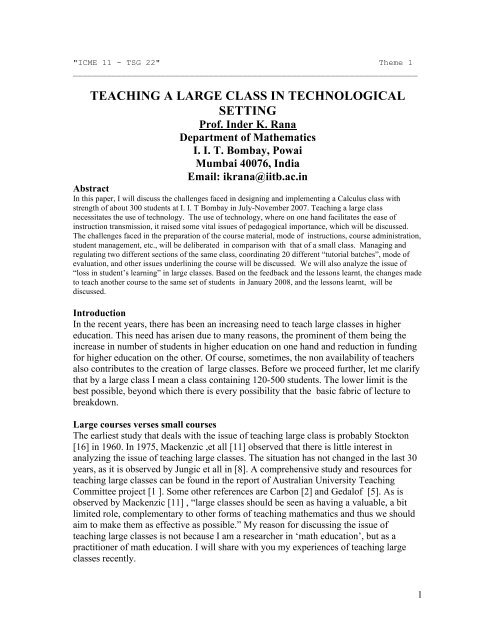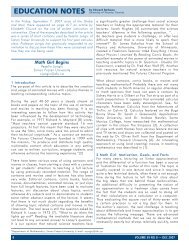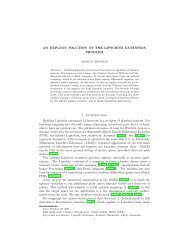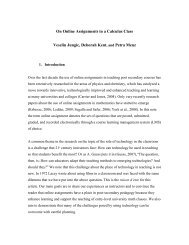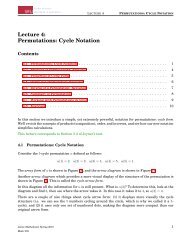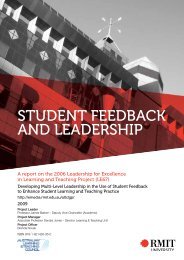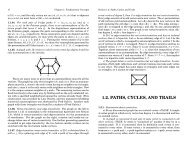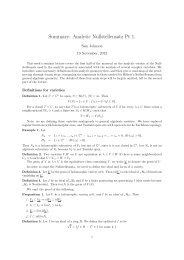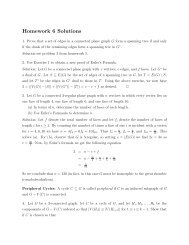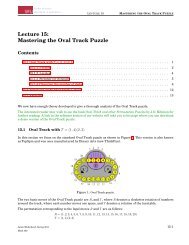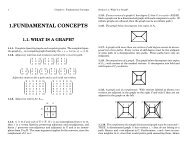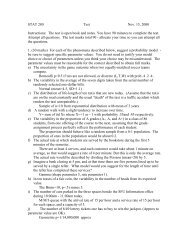teaching a large class in technological setting - People.stat.sfu.ca
teaching a large class in technological setting - People.stat.sfu.ca
teaching a large class in technological setting - People.stat.sfu.ca
You also want an ePaper? Increase the reach of your titles
YUMPU automatically turns print PDFs into web optimized ePapers that Google loves.
"ICME 11 - TSG 22" Theme 1<br />
_______________________________________________________________________<br />
TEACHING A LARGE CLASS IN TECHNOLOGICAL<br />
SETTING<br />
Prof. Inder K. Rana<br />
Department of Mathematics<br />
I. I. T. Bombay, Powai<br />
Mumbai 40076, India<br />
Email: ikrana@iitb.ac.<strong>in</strong><br />
Abstract<br />
In this paper, I will discuss the challenges faced <strong>in</strong> design<strong>in</strong>g and implement<strong>in</strong>g a Calculus <strong>class</strong> with<br />
strength of about 300 students at I. I. T Bombay <strong>in</strong> July-November 2007. Teach<strong>in</strong>g a <strong>large</strong> <strong>class</strong><br />
necessitates the use of technology. The use of technology, where on one hand facilitates the ease of<br />
<strong>in</strong>struction transmission, it raised some vital issues of pedagogi<strong>ca</strong>l importance, which will be discussed.<br />
The challenges faced <strong>in</strong> the preparation of the course material, mode of <strong>in</strong>structions, course adm<strong>in</strong>istration,<br />
student management, etc., will be deliberated <strong>in</strong> comparison with that of a small <strong>class</strong>. Manag<strong>in</strong>g and<br />
regulat<strong>in</strong>g two different sections of the same <strong>class</strong>, coord<strong>in</strong>at<strong>in</strong>g 20 different “tutorial batches”, mode of<br />
evaluation, and other issues underl<strong>in</strong><strong>in</strong>g the course will be discussed. We will also analyze the issue of<br />
“loss <strong>in</strong> student’s learn<strong>in</strong>g” <strong>in</strong> <strong>large</strong> <strong>class</strong>es. Based on the feedback and the lessons learnt, the changes made<br />
to teach another course to the same set of students <strong>in</strong> January 2008, and the lessons learnt, will be<br />
discussed.<br />
Introduction<br />
In the recent years, there has been an <strong>in</strong>creas<strong>in</strong>g need to teach <strong>large</strong> <strong>class</strong>es <strong>in</strong> higher<br />
edu<strong>ca</strong>tion. This need has arisen due to many reasons, the prom<strong>in</strong>ent of them be<strong>in</strong>g the<br />
<strong>in</strong>crease <strong>in</strong> number of students <strong>in</strong> higher edu<strong>ca</strong>tion on one hand and reduction <strong>in</strong> fund<strong>in</strong>g<br />
for higher edu<strong>ca</strong>tion on the other. Of course, sometimes, the non availability of teachers<br />
also contributes to the creation of <strong>large</strong> <strong>class</strong>es. Before we proceed further, let me clarify<br />
that by a <strong>large</strong> <strong>class</strong> I mean a <strong>class</strong> conta<strong>in</strong><strong>in</strong>g 120-500 students. The lower limit is the<br />
best possible, beyond which there is every possibility that the basic fabric of lecture to<br />
breakdown.<br />
Large courses verses small courses<br />
The earliest study that deals with the issue of <strong>teach<strong>in</strong>g</strong> <strong>large</strong> <strong>class</strong> is probably Stockton<br />
[16] <strong>in</strong> 1960. In 1975, Mackenzic ,et all [11] observed that there is little <strong>in</strong>terest <strong>in</strong><br />
analyz<strong>in</strong>g the issue of <strong>teach<strong>in</strong>g</strong> <strong>large</strong> <strong>class</strong>es. The situation has not changed <strong>in</strong> the last 30<br />
years, as it is observed by Jungic et all <strong>in</strong> [8]. A comprehensive study and resources for<br />
<strong>teach<strong>in</strong>g</strong> <strong>large</strong> <strong>class</strong>es <strong>ca</strong>n be found <strong>in</strong> the report of Australian University Teach<strong>in</strong>g<br />
Committee project [1 ]. Some other references are Carbon [2] and Gedalof [5]. As is<br />
observed by Mackenzic [11] , “<strong>large</strong> <strong>class</strong>es should be seen as hav<strong>in</strong>g a valuable, a bit<br />
limited role, complementary to other forms of <strong>teach<strong>in</strong>g</strong> mathematics and thus we should<br />
aim to make them as effective as possible.” My reason for discuss<strong>in</strong>g the issue of<br />
<strong>teach<strong>in</strong>g</strong> <strong>large</strong> <strong>class</strong>es is not be<strong>ca</strong>use I am a researcher <strong>in</strong> ‘math edu<strong>ca</strong>tion’, but as a<br />
practitioner of math edu<strong>ca</strong>tion. I will share with you my experiences of <strong>teach<strong>in</strong>g</strong> <strong>large</strong><br />
<strong>class</strong>es recently.<br />
1
Lectures compose the ma<strong>in</strong> tool of <strong>teach<strong>in</strong>g</strong>. The role of a lecturer is to <strong>in</strong>troduce students<br />
to new concepts and their appli<strong>ca</strong>tions. Lecturer should stimulate student’s <strong>in</strong>dependent<br />
th<strong>in</strong>k<strong>in</strong>g. Lectures are more effective when there is a two way communi<strong>ca</strong>tion between<br />
the teacher and the students. This is the ma<strong>in</strong> place where the <strong>large</strong> <strong>class</strong> lectures differ<br />
from small <strong>class</strong> lectures. In small <strong>class</strong> lectures (<strong>class</strong>i<strong>ca</strong>l chalk- blackboard) <strong>teach<strong>in</strong>g</strong>,<br />
students hear the lecture and see the arguments unfold<strong>in</strong>g on the blackboard. This<br />
presents the human face of the subject to them. There is a sense of <strong>in</strong>volvement. They see<br />
how mathematician th<strong>in</strong>ks and how concepts evolve. This helps <strong>in</strong> build<strong>in</strong>g student’s<br />
confidence <strong>in</strong> develop<strong>in</strong>g the arguments. The <strong>large</strong> <strong>class</strong> lecture is essentially a one way<br />
communi<strong>ca</strong>tion process. It <strong>ca</strong>n reduce to achiev<strong>in</strong>g only the m<strong>in</strong>imum aim of <strong>teach<strong>in</strong>g</strong>:<br />
transmitt<strong>in</strong>g the bare fact to enable students to handle rout<strong>in</strong>e exam<strong>in</strong>ation problems.<br />
There are other aspects of <strong>teach<strong>in</strong>g</strong> a <strong>large</strong> <strong>class</strong> that, though appli<strong>ca</strong>ble to small <strong>class</strong>es<br />
also, are more important <strong>in</strong> a <strong>large</strong> <strong>class</strong>. Of course, a condition that is of prime<br />
importance is ‘thorough preparation’ of the subject matter. This is a necessary condition<br />
for a good lecture, but not sufficient. Both, Mackenzic [11], and Jungic [8] compare<br />
lecture of a <strong>large</strong> <strong>class</strong> to theatri<strong>ca</strong>l event: “ …an <strong>in</strong>structor of a <strong>large</strong> <strong>class</strong> is much like<br />
an actor on a stage. In fact, it is a one man show.” Thus, there is a much bigger<br />
responsibility on his shoulders to make the show a success. He has to be well prepared to<br />
ma<strong>in</strong>ta<strong>in</strong> the purpose and achieve it <strong>in</strong> the face of unexpected difficulties. Lectur<strong>in</strong>g to a<br />
<strong>large</strong> <strong>class</strong> <strong>ca</strong>n be both physi<strong>ca</strong>lly and mentally exhaust<strong>in</strong>g, much more than that of a<br />
small <strong>class</strong>. Learn<strong>in</strong>g to use technology itself may be time consum<strong>in</strong>g and frustrat<strong>in</strong>g.<br />
Galbraith [4] <strong>stat</strong>es that “Results suggest, <strong>teach<strong>in</strong>g</strong> demands are <strong>in</strong>creased rather than<br />
decreased by the use of technology, …” The problem of manag<strong>in</strong>g a <strong>large</strong> <strong>class</strong> is also<br />
difficult as compared to that of a small <strong>class</strong>. Lecturer <strong>ca</strong>nnot afford to be <strong>in</strong>formal, as <strong>in</strong><br />
a small <strong>class</strong>. Small human errors (such as <strong>ca</strong>lculation mistakes on gett<strong>in</strong>g stuck <strong>in</strong> an<br />
explanation, etc.) <strong>ca</strong>n lead to uncontrolled <strong>in</strong>terruptions <strong>in</strong> a <strong>large</strong> <strong>class</strong>. However, such<br />
<strong>in</strong>cidents (if not frequent), <strong>ca</strong>n help students to <strong>in</strong>cul<strong>ca</strong>te a criti<strong>ca</strong>l attitude for the lecturer.<br />
Another issue which is almost nonexistent <strong>in</strong> small <strong>class</strong> is that of use of technology <strong>in</strong><br />
prepar<strong>in</strong>g and deliver<strong>in</strong>g lectures. The need for the lecturer to be conversed with the use<br />
of technology (hardware and software) is of paramount importance and adds a new<br />
dimension <strong>in</strong> qualities required of teachers of <strong>large</strong> <strong>class</strong>es. Mackenzie [11], <strong>in</strong> 1975<br />
purposed effective use of television (technology at that time ). In the present scenario,<br />
there are multiple options available for all aspects of <strong>teach<strong>in</strong>g</strong> <strong>large</strong> <strong>class</strong>es. I will discuss<br />
some of them <strong>in</strong> the next section.<br />
Issues like that of advance, detailed plann<strong>in</strong>g of the courses, contents, preparation of<br />
‘course slides’, coord<strong>in</strong>ation of tutorial batches, plann<strong>in</strong>g and conduct<strong>in</strong>g assessment are<br />
various issues that assures more importance <strong>in</strong> <strong>large</strong> <strong>class</strong>es.<br />
Work<strong>in</strong>g Model (Calculus Course )<br />
The course:<br />
Indian Institute of Technology Bombay (IITB) is one of the premier <strong>in</strong>stitutes <strong>in</strong> India.<br />
One of the ma<strong>in</strong> aims of IITB if to edu<strong>ca</strong>te eng<strong>in</strong>eer<strong>in</strong>g students. Each of the about<br />
(approximately 580) students is expected to undergo 2-3 semester of “core courses” <strong>in</strong><br />
2
asic sciences: mathematics, physics and chemistry. IITB offers three core courses <strong>in</strong><br />
Mathematics for eng<strong>in</strong>eer<strong>in</strong>g (B.Tech.) students. The first course on <strong>ca</strong>lculus is offered <strong>in</strong><br />
the first semester with three 55 m<strong>in</strong>utes lectures per week for 13-14 weeks. Till April<br />
2007, the students were divided <strong>in</strong>to four sections, each of approximately 140 students.<br />
Each section had an <strong>in</strong>structor for lectures. For tutorials, each section was divided <strong>in</strong>to 5<br />
batches of approximately 25-30 students. Each batch used to be assigned a course<br />
associate. The mode of <strong>in</strong>struction used to be <strong>class</strong>i<strong>ca</strong>l blackboard –chalk method. In the<br />
beg<strong>in</strong>n<strong>in</strong>g of 2007, it <strong>ca</strong>me to be known that the student strength may have to be<br />
<strong>in</strong>creased as much as by 20% <strong>in</strong> the next a<strong>ca</strong>demic year beg<strong>in</strong>n<strong>in</strong>g <strong>in</strong> July 2007. It was<br />
felt that it may not be possible to <strong>in</strong>crease faculty strength at such a short notice. Thus it<br />
was decided to experiment <strong>teach<strong>in</strong>g</strong> of the first year <strong>ca</strong>lculus course <strong>in</strong> <strong>large</strong> <strong>class</strong>. For<br />
this, all the students were divided <strong>in</strong>to two divisions of approximately 290 students each.<br />
We will discuss the plann<strong>in</strong>g, execution, and outcomes of <strong>teach<strong>in</strong>g</strong> this course. A similar<br />
experiment ([7]), was conducted <strong>in</strong> 1997and the system was reverted to the <strong>class</strong>i<strong>ca</strong>l one<br />
after two years.<br />
The students:<br />
The students for B. Tech. courses at I.I.T. Bombay have almost uniform mathemati<strong>ca</strong>l<br />
ability. They are selected through a tough entrance exam<strong>in</strong>ation, and are supposed to be<br />
‘best’ <strong>in</strong> the country.<br />
The course preparation:<br />
The course had two <strong>in</strong>structors, one for each division of 290 plus students. Both the<br />
<strong>in</strong>structors jo<strong>in</strong>tly prepared the follow<strong>in</strong>g:<br />
• A detailed outl<strong>in</strong>e of the course contents. List of the specific topics to be covered<br />
<strong>in</strong> each lecture and the reference from the prescribed textbook. This helped <strong>in</strong><br />
keep<strong>in</strong>g pace of the <strong>in</strong>structors uniform <strong>in</strong> both the divisions.<br />
• Details of the various policies regard<strong>in</strong>g attendance rules, miss<strong>in</strong>g of a test/ quiz,<br />
etc., to be told to students.<br />
• Detailed set of problem sheets (one for each week) to be covered <strong>in</strong> the tutorial<br />
<strong>class</strong>es.<br />
• Detailed solutions of problem sheets for the course associates (TAs) <strong>in</strong> charge for<br />
conduct<strong>in</strong>g tutorial <strong>class</strong>es.<br />
• Detailed assessment procedures, schedul<strong>in</strong>g of <strong>class</strong> tests, quizzes and their<br />
weightages towards the f<strong>in</strong>al grades.<br />
All this material was prepared <strong>in</strong> the form of a booklet and distributed to the students on<br />
the first day of the <strong>in</strong>structions.<br />
Lectures:<br />
The course was assigned three 55 m<strong>in</strong>utes lectures per week and a tutorial of one hour per<br />
week. All the lectures were held <strong>in</strong> an auditorium with audio-visual support. S<strong>in</strong>ce LCD<br />
3
projection was available, it was decided to prepare electronic slides of lectures.<br />
Advantages of electronic slides are that they <strong>ca</strong>n be prepared <strong>in</strong> advance improv<strong>in</strong>g<br />
organization of the presentation. Also they provide a means of show<strong>in</strong>g <strong>in</strong>formation-rich<br />
content: formulas, graphs and diagrams is an effective way. Further, they afford<br />
<strong>in</strong>stantaneous display and the advantage of be<strong>in</strong>g flexible <strong>in</strong> term of ease of preparation,<br />
shar<strong>in</strong>g, and modifi<strong>ca</strong>tion after presentations. For this, the lecture material was typeset <strong>in</strong><br />
Latex. It helped <strong>in</strong> prepar<strong>in</strong>g lecture notes for pr<strong>in</strong>t<strong>in</strong>g and prepar<strong>in</strong>g slides for lectures.<br />
For prepar<strong>in</strong>g slides us<strong>in</strong>g LaTex, many options are available: Prosper, Beamer, Sem<strong>in</strong>ar,<br />
Foiltx, etc. All these are ‘add-ons’ which help to produce beautiful slides <strong>in</strong> PDF format<br />
with <strong>in</strong>cremental display. We selected Prosper [14]. A typi<strong>ca</strong>l snapshot of the lecture<br />
slide is as below:<br />
The <strong>in</strong>cremental display helped to control the display. For the delivery of the lectures,<br />
each <strong>in</strong>structor had his own Tablet PC. The idea was that the <strong>in</strong>structor <strong>ca</strong>n use it to<br />
display lectures and the Tablet facility (W<strong>in</strong>dows journal), <strong>ca</strong>n be used to expla<strong>in</strong><br />
additional items not covered <strong>in</strong> the slides. The use of Tablet PC and other audio-visual<br />
support needed that the <strong>in</strong>structors got used to their use. Also, it (use of technology)<br />
needed the <strong>in</strong>structors to arrive at the lecture hall at least five m<strong>in</strong>utes early (to hook up<br />
the Tablet PC, start it up and for other techni<strong>ca</strong>l sett<strong>in</strong>g). However, this had a positive<br />
effect on the students as they found the teacher present before they arrived. It also gave<br />
<strong>in</strong>structors sometime to <strong>in</strong>teract with some students.<br />
Time and student management is a challenge <strong>in</strong> a <strong>large</strong> <strong>class</strong>. Mak<strong>in</strong>g students come <strong>in</strong><br />
time, settle down quickly, avoid talk<strong>in</strong>g to each other and so on are the issues that the<br />
<strong>in</strong>structor has to manage. Though each <strong>in</strong>structor has his own way of f<strong>in</strong>d<strong>in</strong>g solutions, I<br />
4
found that sett<strong>in</strong>g the rules of the game <strong>in</strong> the beg<strong>in</strong>n<strong>in</strong>g and lett<strong>in</strong>g the student know that<br />
what is expected is a good idea. This worked <strong>in</strong> my <strong>ca</strong>se.<br />
Of course, there is the issue of oc<strong>ca</strong>sionally ‘a<strong>ca</strong>demic slip’, dur<strong>in</strong>g the lectures, which<br />
<strong>ca</strong>n <strong>ca</strong>use ‘unrest’ <strong>in</strong> the <strong>class</strong>. This did happen to me once or twice, but was managed by<br />
accept<strong>in</strong>g the mistake and correct<strong>in</strong>g it <strong>in</strong> the <strong>class</strong> itself. I tried <strong>in</strong> our own way, to<br />
<strong>in</strong>duce student participation <strong>in</strong> the <strong>class</strong>. Oc<strong>ca</strong>sionally, students were asked to do ‘small<br />
exercises’ <strong>in</strong> the <strong>class</strong>, or their suggestions were asked about solv<strong>in</strong>g a particular po<strong>in</strong>t.<br />
S<strong>in</strong>ce <strong>in</strong>structors had a wireless ‘Collar-microphone’, they could move <strong>in</strong> the hall dur<strong>in</strong>g<br />
these a<strong>ca</strong>demic breaks. Another way of giv<strong>in</strong>g short ‘a<strong>ca</strong>demic breaks’ was the use of<br />
‘Java Applets’ and ‘Flash Animations’ to illustrate a concept (some of these are available<br />
at www.math4all.<strong>in</strong>, www.mathresource.iitb.ac.<strong>in</strong>).<br />
In the <strong>large</strong> <strong>class</strong> it is difficult to enterta<strong>in</strong> <strong>in</strong>dividual questions. Also <strong>in</strong> <strong>large</strong> <strong>class</strong>es,<br />
many students tend to rema<strong>in</strong> anonymous. I really had no way of tackl<strong>in</strong>g this issue. To<br />
enable students to be able to refer to the material of the course, sufficient copies of the<br />
text/reference books were made <strong>in</strong> available <strong>in</strong> the library. S<strong>in</strong>ce the lecture hall had dim<br />
lights and seats had no side support for written, it was decided to make detailed lecture<br />
notes available to the students (at a low cost). These notes had essentially the content<br />
covered <strong>in</strong> the lectures.<br />
The issue of attendance <strong>in</strong> a <strong>large</strong> <strong>class</strong> rema<strong>in</strong>ed unresolved. No effective<br />
methodology could be evolved. It was decided not to take attendance <strong>in</strong> the <strong>class</strong>, but<br />
implement strict attendance rules for ‘tutorial <strong>class</strong>es’. No attendance dur<strong>in</strong>g lectures and<br />
the availability of complete lecture notes was a dar<strong>in</strong>g step. However, I found that<br />
attendance <strong>in</strong> the <strong>class</strong> was about 80%, most of the time. This also strengthened the belief<br />
that human <strong>in</strong>teraction is needed for learn<strong>in</strong>g.<br />
Tutorials:<br />
In <strong>large</strong> <strong>class</strong> scenario, it is important that there should be strong tutorial support. Each<br />
division was divided <strong>in</strong>to 5 batches of size 25-30 students. Each batch was assigned a<br />
course associate (a research scholar <strong>in</strong> the department). To ensure that all the course<br />
associates are clear about the material be<strong>in</strong>g taught, a copy of lecture plan and lecture<br />
notes were given to them. Further, a weekly meet<strong>in</strong>g of the associates was held to discuss<br />
the problems to be done <strong>in</strong> that week’s tutorial <strong>class</strong>. The methodology adopted <strong>in</strong> the<br />
tutorial <strong>class</strong> prompted students to discuss problems among themselves and with the<br />
course associates.<br />
Outside <strong>class</strong>room support:<br />
In addition to give students support outside the <strong>class</strong>room, office hours were fixed for<br />
both the <strong>in</strong>structors as well as all the course associates. Dur<strong>in</strong>g these hours students<br />
could contact the <strong>in</strong>structors and the course associates to clarify their doubts. To give<br />
onl<strong>in</strong>e support and to provide a medium to raise and discuss their doubts ‘Moodle’ was<br />
used. (Moodle [13] is a free, Open Source software package designed us<strong>in</strong>g sound<br />
pedagogi<strong>ca</strong>l pr<strong>in</strong>ciples, to help edu<strong>ca</strong>tors create effective onl<strong>in</strong>e learn<strong>in</strong>g communities.)<br />
Students did make an extensive use of it and it was also useful for the <strong>in</strong>structors to put<br />
notices, assignments, and solutions for tests and so on.<br />
5
At the end of the course, to obta<strong>in</strong> students feedback, a set of 20 questions were asked<br />
<strong>in</strong> an onl<strong>in</strong>e anonymous survey. For this we used FAST-The Free Assessment Summary<br />
Tool developed by Mount Royal College [5]. We list below the questions and survey<br />
results which are important from pedagogy po<strong>in</strong>t of view:<br />
Survey (118 respondents) questions:<br />
1) I liked the LCD/PowerPo<strong>in</strong>t mode of lectures as compared to traditional chalkblackboard<br />
method.<br />
Strongly Disagree Disagree Not Agree Strongly<br />
Appli<strong>ca</strong>ble<br />
Agree<br />
56 (47%) 34 (29%) 6 (5%) 14 (12%) 8 (7%)<br />
2) LCD /PowerPo<strong>in</strong>t mode of lectures is reasonably <strong>in</strong>teractive.<br />
Strongly Disagree Disagree Not Agree Strongly<br />
Appli<strong>ca</strong>ble<br />
Agree<br />
50 (42%) 40 (34%) 8 (7%) 17(14%) 3(3%)<br />
3) PowerPo<strong>in</strong>t is an effective tool for help<strong>in</strong>g me understand the course content.<br />
Strongly Disagree Disagree Not Appli<strong>ca</strong>ble Agree Strongly<br />
Agree<br />
46(39%) 38 (32%) 13 (11%) 17(14%) 4(3%)<br />
4) Animations/visualizations <strong>in</strong> the lectures were good and they helped <strong>in</strong><br />
understand<strong>in</strong>g the concepts.<br />
Strongly Disagree Disagree Not Appli<strong>ca</strong>ble Agree Strongly<br />
Agree<br />
8(7%) 15 (13%) 18(7%) 57(14%) 17(3%)<br />
5) Giv<strong>in</strong>g detailed lecture notes is a<br />
good idea.<br />
6) Availability of complete lecture notes prompted to miss <strong>class</strong>es.<br />
Yes No<br />
97(82%) 21 (18%)<br />
Strongly Disagree Disagree Not Appli<strong>ca</strong>ble Agree Strongly<br />
Agree<br />
19(16%) 38 (32%) 13(11%) 32(27%) 16(14%)<br />
6
7) Be<strong>ca</strong>use of PowerPo<strong>in</strong>t mode, <strong>in</strong>structor went fast.<br />
Strongly Disagree Disagree Not Appli<strong>ca</strong>ble Agree Strongly<br />
Agree<br />
5 (4%) 6 (5%) 2 (2%) 52 (44%) 53 (45%)<br />
8) Though complete notes were available, lectures were useful <strong>in</strong> understand<strong>in</strong>g the<br />
concepts.<br />
Strongly Disagree Disagree Not Appli<strong>ca</strong>ble Agree Strongly<br />
Agree<br />
15(13%) 24 (20%) 14(12%) 56 (47%) 9 (8%)<br />
9) Instructor encouraged students to <strong>in</strong>teract , ask questions <strong>in</strong> the lectures, and<br />
established rapport with students dur<strong>in</strong>g the lectures.<br />
Strongly Disagree Disagree Not Appli<strong>ca</strong>ble Agree Strongly<br />
Agree<br />
17 (14%) 32 (27%) 20 (17%) 40 (34%) 9 (8%)<br />
10) Instructor was approachable and<br />
provided opportunities for help<br />
(e.g. office hours, emails, web-<br />
site).<br />
Yes No<br />
97(82%) 21 (18%)<br />
Conclusions:<br />
In my view, LCD-PowerPo<strong>in</strong>t method of deliver<strong>in</strong>g lectures from premade slides is a<br />
good idea as it saves time <strong>in</strong> writ<strong>in</strong>g, and time <strong>ca</strong>n be effectively used to expla<strong>in</strong><br />
concepts. Also s<strong>in</strong>ce the students were given complete notes, it was felt that students will<br />
be spared from the dual task of writ<strong>in</strong>g and understand<strong>in</strong>g. However, <strong>teach<strong>in</strong>g</strong> from preprepared<br />
electronic slides comes at the expense of the ability to freely <strong>in</strong>teract with<br />
students dur<strong>in</strong>g the lectures and to adjust the lecture at the request of the students. This<br />
was confirmed by students op<strong>in</strong>ions (Questions 1, 2 and 3), despite of the fact that the<br />
efforts were made to have <strong>in</strong>teraction (Question 9) , and that they had complete set of<br />
notes (Question 5). Students attitude <strong>ca</strong>n only be rationalized by the fact that these<br />
students are gett<strong>in</strong>g taught <strong>in</strong> this mode for the first time (all school edu<strong>ca</strong>tion <strong>in</strong> India is<br />
<strong>in</strong> blackboard-chalk method). Also this mode of <strong>teach<strong>in</strong>g</strong> puts a greater responsibility on<br />
the students. It is worth po<strong>in</strong>t<strong>in</strong>g that the f<strong>in</strong>al results of the students : based on two <strong>class</strong><br />
tests (30% weight age), mid-semester exam<strong>in</strong>ation (30% weight age) and end-semester<br />
exam<strong>in</strong>ation (40% weight age) , only 6% students failed the course. Response to<br />
Question 4 also strengthened the belief that animations and visualizations give needed<br />
break <strong>in</strong> the lectures and they do help students <strong>in</strong> understand<strong>in</strong>g concepts.<br />
Work<strong>in</strong>g Model (L<strong>in</strong>ear Algebra Course)<br />
Based on the feedback received from the students, I wanted to modify my mode of<br />
<strong>in</strong>structions and test it impact. I offered to teach next course (L<strong>in</strong>ear Algebra) to same set<br />
7
of students with same strength <strong>in</strong> the same LCD sett<strong>in</strong>g. It was clear that electronic slides<br />
tend to be rigid and do not provide flexible mechanisms to adapt the lectures on demand .<br />
An important part of lectur<strong>in</strong>g is to have the ability to adjust material <strong>in</strong> response to<br />
student reactions and develop<strong>in</strong>g spontaneous examples and explanations to clarify and<br />
expand on topics. I wanted a presentation system that will provide a dynamic and<br />
<strong>in</strong>teractive learn<strong>in</strong>g environment which fully engages students. I realized that I am not<br />
effectively us<strong>in</strong>g the technology. Tablet function allows for the <strong>in</strong>teraction with<br />
audiences dur<strong>in</strong>g lectures through on-screen annotation with handwritten electronic<br />
<strong>in</strong>k<strong>in</strong>g. This br<strong>in</strong>gs <strong>class</strong>room sett<strong>in</strong>g more closer to the <strong>class</strong>i<strong>ca</strong>l blackboard-chalk setup.<br />
Comb<strong>in</strong><strong>in</strong>g electronic slides and digital <strong>in</strong>k us<strong>in</strong>g the Tablet PC are also possible. In the<br />
<strong>teach<strong>in</strong>g</strong> model that I will discuss, an <strong>in</strong>structor loads a presentation composed of a deck<br />
of electronic slides onto a tablet computer. The <strong>in</strong>structor writes on the slides with the<br />
tablet’s pen and control the presentation by <strong>in</strong>vok<strong>in</strong>g controls that are displayed on Tablet<br />
PC. The usefulness of electronic <strong>in</strong>k for lecture delivery has been discussed <strong>in</strong> a number<br />
of edu<strong>ca</strong>tional research papers: Simon et al [15], Loch [9], Loomes et al [10]. For the<br />
electronic slides I selected Classroom Presenter [8]. It is a presentation system that<br />
comb<strong>in</strong>es the advantages of exist<strong>in</strong>g computer-based systems with the handwrit<strong>in</strong>g<br />
flexibility of manual systems. As described by its developers, on a Tablet PC, Classroom<br />
Presenter allows the <strong>in</strong>structor to handwrite over computer-projected slides. It is available<br />
free for edu<strong>ca</strong>tional and research use and <strong>ca</strong>n be downloaded from [3]. The electronic<br />
slides prepared for Classroom Presenter had only the outl<strong>in</strong>es of the topics with sufficient<br />
blank space to be filled with digital <strong>in</strong>k dur<strong>in</strong>g the lectures.. Rest of the setup for this<br />
course was same as <strong>in</strong> earlier model.<br />
At the end of the course (this was only for six weeks), students were aga<strong>in</strong> asked their<br />
op<strong>in</strong>ions about the course. The results are as follows:<br />
Survey (94 respondents) questions:<br />
1) I liked the LCD-PowerPo<strong>in</strong>t<br />
mode of lectures as compared to<br />
that of MA 105 last semester.<br />
2) This LCD -PowerPo<strong>in</strong>t mode of<br />
lectures is reasonably <strong>in</strong>teractive.<br />
3) This mode of lectures is an<br />
effective way to understand the<br />
course content.<br />
4) Even though the mode of<br />
<strong>in</strong>struction was of PowerPo<strong>in</strong>t ,<br />
pace of the lectures was not fast.<br />
Yes No<br />
80(85%) 14 (15%)<br />
Yes No<br />
67 (71%) 27 (29%)<br />
Yes No<br />
61 (65%) 33 (35%)<br />
Yes No<br />
41 (44%) 53 (56%)<br />
8
5) Giv<strong>in</strong>g detailed lecture noted is a<br />
good idea.<br />
6) Availability of complete lecture<br />
notes prompted to miss <strong>class</strong>es.<br />
7) Though complete notes were<br />
available, lectures were useful <strong>in</strong><br />
understand<strong>in</strong>g the concepts.<br />
8) I attended more than 75 %<br />
lectures (even though the<br />
attendance was not compulsory).<br />
Yes No<br />
74 (79%) 20 (21%)<br />
Yes No<br />
27 (29%) 67 (71%)<br />
Yes No<br />
64 (68%) 30 (32%)<br />
Yes No<br />
82 (87%) 12 (13%)<br />
9) Given that future <strong>class</strong> strength is likely to be 300, do you th<strong>in</strong>k this mode of<br />
lectures is best suited?<br />
Strongly Disagree Not Appli<strong>ca</strong>ble Agree Strongly<br />
Disagree<br />
Agree<br />
23 (23%) 18 (19%) 9 (10%) 36 (38%) 9 (10%)<br />
Comparison of the two models:<br />
From the responses to Questions 1 to 4, it is clear that the mode of lecture presentation as<br />
adopted <strong>in</strong> the second model is more acceptable to majority as compared to the earlier<br />
model. Still, the pace of lectures seemed fast. The conclusion that lecture notes lend<br />
great support is aga<strong>in</strong> reiterated as <strong>in</strong> responses to questions 5 to 8. However, majority of<br />
the students is still not conv<strong>in</strong>ced that given <strong>class</strong> strength of about 300, this is a good<br />
way of transmitt<strong>in</strong>g lectures. At this stage it is <strong>in</strong>terest<strong>in</strong>g to po<strong>in</strong>t out that though this<br />
system of lectures was more acceptable to students, the f<strong>in</strong>al results <strong>in</strong>di<strong>ca</strong>ted that 9.5%<br />
students failed the course, as compared to 6% for the earlier course.<br />
Overall conclusions:<br />
• Many faculty members and edu<strong>ca</strong>tion planners feel that that <strong>large</strong> <strong>class</strong>es mean a<br />
loss <strong>in</strong> the learn<strong>in</strong>g processes of students. However, as is mentioned <strong>in</strong> AUTC<br />
[1], under Institutional Policies,“…there is no conclusive evidence to suggest that<br />
reduction of <strong>class</strong> size, by itself, has any signifi<strong>ca</strong>nt positive effects on student<br />
performances” At the same time Maxwell and Lopus [12] say “…<strong>in</strong>crease <strong>in</strong> size<br />
resulted <strong>in</strong> substantial monetary sav<strong>in</strong>gs without loss <strong>in</strong> learn<strong>in</strong>g,…students <strong>in</strong><br />
<strong>large</strong> <strong>class</strong>es experienced greater dissatisfaction with the learn<strong>in</strong>g experience”.<br />
This is also supported by the results of earlier model.<br />
• From student’s po<strong>in</strong>t of view, <strong>large</strong> <strong>class</strong>es, though not very satisfactory, are not a<br />
real h<strong>in</strong>drance <strong>in</strong> learn<strong>in</strong>g. It is only gett<strong>in</strong>g used to the new mode (as is <strong>in</strong>di<strong>ca</strong>ted<br />
by student’s responses <strong>in</strong> question 9 <strong>in</strong> second model).<br />
9
• Pure pre-made electronic slides give teacher little room for extrapolation and for<br />
students it is passive learn<strong>in</strong>g. Partially outl<strong>in</strong>ed slides with room for annotation<br />
(with Classroom Presenter) were found satisfactory for both the <strong>in</strong>structor and the<br />
students.<br />
• Availability of lecture notes give students much needed support outside the <strong>class</strong><br />
room (Question 5 <strong>in</strong> both the work<strong>in</strong>g models).<br />
• Technology has a positive role to play both <strong>in</strong> the processes of deliver<strong>in</strong>g the<br />
lectures ( Tablet PC, LCD projection, electronic slides, Classroom Presenter) and<br />
mak<strong>in</strong>g it more illustrative by <strong>in</strong>clud<strong>in</strong>g Java applets and Flash animations (as is<br />
clear by student’s responses to Question 4 <strong>in</strong> first work<strong>in</strong>g model).<br />
• The issue of tak<strong>in</strong>g attendance <strong>in</strong> <strong>large</strong> <strong>class</strong> rema<strong>in</strong>s unanswered.<br />
References:<br />
[1] AUTC Teach<strong>in</strong>g Large Class Project(2001), http://www.tedi.uq.edu.au/<strong>large</strong><strong>class</strong>es/<br />
[2] Carbon,E. “Teach<strong>in</strong>g Large Classes: Tools and Strategies” SAGE Publi<strong>ca</strong>tions,<br />
California (1998).<br />
[3] Classroom Presenter http://www.cs.wash<strong>in</strong>gton.edu/edu<strong>ca</strong>tion/dl/presenter.<br />
[4] Galbraith, Peter (2002). "Life wasn't meant to be easy": Separat<strong>in</strong>g wheat from chaff<br />
<strong>in</strong> Technology Aided Learn<strong>in</strong>g . Proceed<strong>in</strong>gs of the second <strong>in</strong>ternational conference on<br />
the <strong>teach<strong>in</strong>g</strong> of mathematics, Crete,<br />
http://www.math.uoc.gr/~ictm2/Proceed<strong>in</strong>gs/ICTM2_Proceed<strong>in</strong>gs_Table_of_Contents.ht<br />
ml<br />
[5] Gedalof, A. “Green Guide: Teach<strong>in</strong>g Large Classes”,<br />
http://www.uwo.<strong>ca</strong>/tsc/theguide.html<br />
[6] FAST http://www.getfast.<strong>ca</strong><br />
[7] Ghorpade, Sudhir R.“Teach<strong>in</strong>g Calculus us<strong>in</strong>g Internet: Some Experiments and<br />
Experiences” Proceed<strong>in</strong>gs of the CASTME-UNESCO-HBCSE International Conference<br />
Science, Technology and Mathematics Edu<strong>ca</strong>tion for Human Development, Eds., S. C.<br />
Agarkar and V. D. Lale , Homi Bhabha Centre for Science Edu<strong>ca</strong>tion, Tata Institute of<br />
Fundamental Research, Mumbai, Vol. 1,(2002), pp. 219-223.<br />
[8] Jungic, Vesel<strong>in</strong>, Deborah Kent, Peter Menz “Teach<strong>in</strong>g Large Classes: Three<br />
Instructors, One Experience “ IEJME 1(2006), pp. 1-15<br />
10
[9] Loch, B. “Tablet Technology <strong>in</strong> First Year Calculus and L<strong>in</strong>ear Algebra Teach<strong>in</strong>g”<br />
Proc. of the Fifth Southern Hemisphere Conference on Undergraduate Mathematics and<br />
Statistics Teach<strong>in</strong>g and Learn<strong>in</strong>g (K<strong>in</strong>gfisher Delta’05), 231-237.<br />
[10] Loomes, M., Shafarenko, A., and Loomes, M. “Teach<strong>in</strong>g mathemati<strong>ca</strong>l explanation<br />
through audiographic technology”, Computers & Edu<strong>ca</strong>tion, vol.38 (2002), 137-149.<br />
[11] Mackenzie, D.E, Gary, J. D., Prokhovnik, S. J. “Large Group Lectur<strong>in</strong>g <strong>in</strong><br />
Mathematics” Edu<strong>ca</strong>tional Studies <strong>in</strong> Mathematics 6(1975), pp. 293-309.<br />
[12] Maxwell, N & Lopus, J. “ A cost effectiveness analysis of <strong>large</strong> and small <strong>class</strong>es <strong>in</strong><br />
the university” du<strong>ca</strong>tional Evaluation and Policy Analysis” 17(1995) pp. 167-178.<br />
[13] Moodle http://moodle.org/<br />
[14] Prosper: http://freshmeat.net/articles/view/667/<br />
[15] Simon, B., Anderson, R., and Wolfman, S. “Activat<strong>in</strong>g computer architecture with<br />
Classroom Presenter”, WCAE2003.<br />
[16] Stockton, D. S. “An experiment with a <strong>large</strong> <strong>class</strong>”, Amer.Math. Monthly, 67(1960),<br />
1024-1025.<br />
[17] Townsley, L. “Multimedia Classes: Can there ever be too much technology?” Proc.<br />
of the Vienna International Symposium on Integrat<strong>in</strong>g Technology <strong>in</strong>to Mathematics<br />
Edu<strong>ca</strong>tion (2002), Vienna, Austria.<br />
11


